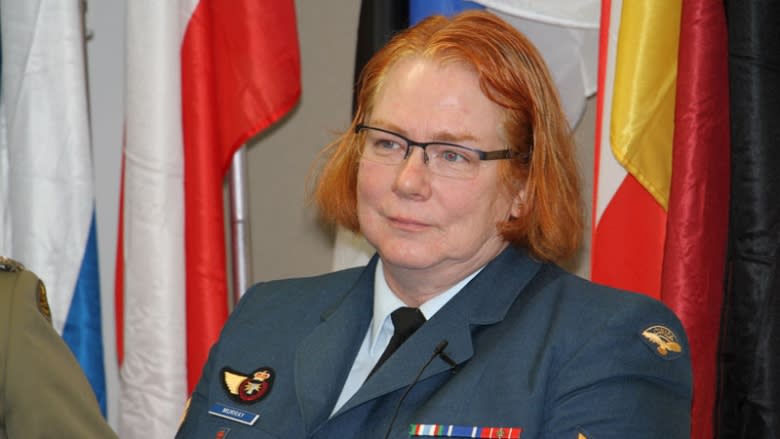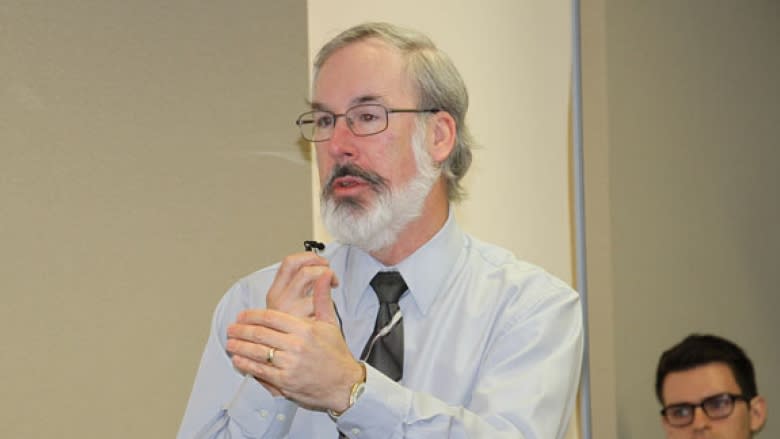U.S. military urged to follow Canada's transgender policy
There are many things that make Canada distinct from the United States but aside from the usual clichés — passion for hockey, maple syrup, and Timbits — there is perhaps a lesser known difference when it comes to our militaries.
The Canadian Forces has something the American military does not: a policy that allows transgender people to serve. In the U.S., Pentagon rules prohibit transgender members and if they're discovered, the military can discharge them.
At a conference on Monday in Washington, D.C., Canada was held up as a model for the U.S. to follow, along with other countries that allow transgender members including Australia, the United Kingdom, Sweden and New Zealand.
Canadian Lt.-Cmdr. Nicole Lassaline spoke on a panel about Canada's policies, medical and otherwise, and best practices, and Cpl. Natalie Murray shared her personal experience as a transsexual woman who transitioned from male to female while in the air force.
"I love my job," Murray said in an interview. But despite Canada's more accommodating policy, it still hasn't been a smooth ride for her over the past decade.
"It was rough to say the least," she said. Murray, who currently works at CFBComox on Vancouver Island, began her transition in 2003 and was the eighth Canadian Forces member to do so.
She said she experienced harassment and that some of her coworkers, and superiors, tried to force her out of her job. Before Comox, Murray worked at CFB Bagotville, CFB North Bay, was deployed to Bosnia and also worked at CFB Trenton.
"They wanted to get rid of me as quickly as they could, either out of the military, out of the Canadian Forces as a whole or for that matter off the planet — which they came very close to doing," said Murray.
Murray echoed the sentiments of other panellists from Sweden, Australia and New Zealand who talked about the stress, depression and feelings of suicide that transgender people hiding their secret can experience.
Professional consequences for some
She also talked about the consequences she's faced professionally. "It didn't come without ramifications for my career. Twenty-seven years done, still this," she said, gesturing to the rank of corporal on the sleeve of her blue uniform. "Corporal for life. Everyone I've ever worked with has moved ahead."
Murray said she is now accepted by her peers in Comox and she tries to help others so they don't have to go through what she did.
The conference was organized by the American Civil Liberties Union and the Palm Center, a research institute affiliated with San Francisco State University.
Advocates are pushing for the Pentagon to drop the ban, but so far, there has been little movement on the issue.
U.S. Defence Secretary Chuck Hagel stated in May when asked in an interview that he's open to reviewing the ban. Some took that as a sign of hope that change was ahead, but no official review is underway at the Pentagon.
In 2010, the policy that banned gay and lesbian military members from being open about their sexuality, known as "Don't Ask, Don't Tell," was repealed. But transgender members still have to work in secret. The Palm Center estimates there are at least 15,000 transgender personnel currently serving in the U.S. military.
There are no statistics for the Canadian Forces. Lassaline said it's a private issue and "not something that's publicized."
Canada also used to ban gay and lesbian members from openly serving in the military. Policies related to sexual orientation and gender identity began to change between 1988 and 1992, partly because of a court challenge, according to Alan Okros, a professor at the Canadian Forces College who spoke at the conference.
Even though Canada has years of experience over the U.S. when it comes to designing inclusive policies, things don't always run smoothly, Okros and Murray both said.
U.S. can learn from Canada
Some people have found great support in the chain of command and from their peers, said Okros, but others have not.
"Others have faced very clear discrimination and prejudice to the point where they left the unit, the occupation. They just cannot put up with serving with the people they were serving with before. It's a range," said Okros.
Okros, a retired Canadian Forces member who has done extensive work on diversity issues, said that the military's top leaders do generally set a tone that emphasizes respect and inclusivity. The challenges more often come up at the ground level, within individual units.
"Quite honestly, it's hit and miss," he said.
Canada isn't perfect, but the U.S. can learn some lessons when it is ready to follow its lead, Okros said.
"I think Canada does have some things to offer and to share in terms of how the U.S. could move forward," he said. "To my mind the real question for the U.S. military is not can they do it, it's just when."
Allyson Robinson, a transgender U.S. army veteran, was trained to fight enemies on the battlefield but now she's fighting the Pentagon's policy.
"The main problem with the U.S. policy is that it's woefully out of date," she said in an interview at the conference. "The obsoleteness of this policy is hurting people. It is hurting 15,000 transgender service members in this country and it's hurting the units they serve and therefore it's a readiness issue for us."
There is no stated rationale for the ban, said Robinson, a policy adviser at SPARTA, an organization for lesbian, gay, bisexual and transgender military members and veterans.
Canada and other allies are setting a positive example, she said. "Some of the most respected militaries in the world figured this out a long time ago, and I think that's a powerful argument here in Washington," she said.



